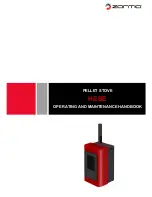
33
Date Printed: 4/28/11
File: G:/pubdata/Manuals\english manuals\OM-KE/PE.pub
OM KE/PE 1006
Version 1.11 Revised: DApril 2011
Operation
Your stove’s performance (including its efficiency, pollutant emission level and service lifetime) depends largely on how it
is operated. You, then, are the most important factor affecting performance. Read these operation instructions carefully.
BEFORE PROCEEDING FURTHER, be sure to read the following:
SAFETY INFORMATION: Pages 12 through 15.
CLEARANCES TO COMBUSTIBLE MATERIALS: Pages 23 through 29.
FLOOR PROTECTION INFORMATION: page 18.
The six major needs of a well-controlled fire are:
1.
A knowledgeable and conscientious operator.
2.
Adequate-air supply and minimum .02” draft.
3.
Firewood of good quality and proper size.
4.
Catalytic combustor in good condition.
5.
Clean chimney, properly sized and installed.
6.
Clean heat exchangers with tight gaskets and seals.
All of these needs are interrelated. A deficiency in any one will affect all of the others If you encounter a problem,
determine the source of the problem and follow up by checking the other needs for possible problems. All things
considered, point number one is the most important for the safe and efficient operation of any stove. Please study the
following carefully, so you may become, and remain, a knowledgeable and conscientious operator.
WARNING - PROVIDE ADEQUATE AIR CIRCULATION
It is essential that a source of fresh air for combustion be provided at all times when this woodstove is in operation. In
extremely tight houses, partially open a window near the woodstove or install an Outside Air Kit.
FUEL
THIS WOODSTOVE IS FOR USE WITH SOLID WOOD FUEL ONLY. NEVER USE GASOLINE, GASOLINE-TYPE
LANTERN FUEL, KEROSENE, CHARCOAL LIGHTER FLUID OR SIMILAR LIQUIDS TO START OR 'FRESHEN UP' A
FIRE IN THIS HEATER. KEEP ALL SUCH LIQUIDS WELL AWAY FROM THE HEATER WHILE IT IS IN USE.
Do not burn materials soaked in flammable liquids, trash, garbage artificial or paper logs, plastics, gift wrappings, coal,
charcoal, naphtha, engine oil, chemical cleaners, chemical fire starters, treated or painted wood, saltwater driftwood,
railroad ties, plywood, particle board. Do not burn sawdust, wood shavings, pellets or chips in this woodstove. The use of
saltwater driftwood will void the warranty.
CAUTION: Do not place wood fuel within the space heater installation clearances or within the space required for fueling
and ash removal.
CAUTION: Do not over fire. If heater or chimney connector glows, you are over firing. Keep loading door and bypass
door closed when stove is in operation.
INITIAL START-UP SEQUENCE
NOTE: As you heat up the stove for the first time, the paint will go through a curing process and will give off an odor. To
minimize the inconvenience, burn the stove at a low temperature setting for several hours. If the odor gets unpleasant,
you may have to open a door or window slightly until the odor dissipates. It might even be a good idea to burn the first
fire with the stove outside.
1.
DO NOT USE A GRATE. BUILD THE FIRE DIRECTLY ON THE BRICK IN THE BOTTOM OF THE STOVE.
2.
Set the thermostat to high (maximum) position, i.e. position at “3”.
3.
Open the loading door and open the by-pass door.
4.
Place five to ten balls of paper in the firebox and place a fairly large quantity (15-20) pieces of kindling on top of the
paper.
5.
Lay two or three medium size (approx. 3") pieces of wood on top of the kindling. Light the fire and allow it to get a
good start but DO NOT LEAVE THE STOVE UNATTENDED.
6.
When the fire has the larger pieces of wood burning, close and latch the loading door, but leave the by-pass door
open. Turning down the thermostat too soon may cause a new fire to go out. Allow the kindling and most of the
larger logs to get started before latching the loading door. DO NOT leave your BLAZE KING unattended when the
doors are not tightly closed. Leaving the loading door open AFTER the fire is well started may cause premature
failure of the catalytic combustor.
















































